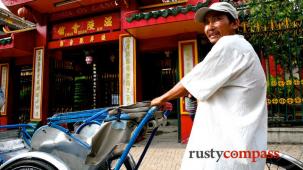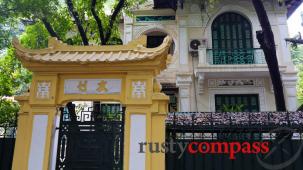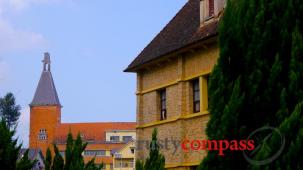Cool? Kitsch? Or both? The New York Times described the Reunification Palace as the sexiest building in South East Asia! This is Vietnam’s most important piece of modern architecture. And the arguments continue to rage about its aesthetic merit. There is no debate however about its place in twentieth century history.
The site was the political heart of Saigon from the time the French inaugurated the Norodom Palace here in 1872 until the end of the Vietnam War in 1975 with an interruption of four years while this structure was built after the French era building was bombed in 1962 and rendered irreparable.
This building is all that remains of the original Norodom Palace which became the residence of the French Governor General of Indochina. The French era Norodom palace was bombed in 1962 by a renegade South Vietnamese pilot trying to assassinate then President Ngo Dinh Diem, who at the time was the major US ally in the escalating Vietnam conflict. The assassins believed Diem was not using sufficient force against the growing communist threat.
Soon after the bombing, Diem commissioned the construction of the Independence Palace on the same site. Diem’s luck ran out in 1963 and he was executed by his own people in a coup that JFK and the CIA quietly gave the nod to. JFK was assassinated himself weeks later. Suffice to say, President Diem never got to spend any time in his new palace. He was three years dead when it opened in 1966.
Perhaps the twentieth century’s most famous gates - images of North Vietnamese tanks crashing through these gates on April 30 1975 were broadcast around the world and came to symbolise the end of the Vietnam War, the unification of the country and the end of America’s failed adventure in Indochina.
The cabinet room above is where 30 years of war came to an end. President Minh, in the job just two days after his two predecessors fled the disintegrating Republic, sat and waited at this table as the North Vietnamese Army seized his newly acquired palace. When he met Communist Colonel, Bui Tin, the President is believed to have said, We have been waiting for you so that we could turn over the government.” Tin reportedly replied “You cannot give what you do not have.” In a bizarre twist of history, both men, the victor and the vanquished ended up in exile in France.
The view from the palace along what is now named Le Duan St. In 1975, the US Embassy was visible a few hundred metres along this road. It is now the site of the US Consulate. The original white tower structure from which the evacuation of Saigon occurred was demolished in 1998. The last US Ambassador to South Vietnam, Graham Martin travelled this road many times to reassure President Thieu of support while in fact, the US Government's resolve to defend South Vietnam had fallen away. Within days of Martin's last visit and Thieu's departure, North Vietnamese tanks took the same path along this road to the palace.
Credentials room - where Ambassadors presented their credentials to the president. One of the more flamboyant rooms, its rear wall features a masterpiece of Vietnamese lacquerwork depicting village life
Lacquer piece, credentials room.
Presidential telephony circa 1975
The red circles mark spots where, on April 8 1975, as the Republic of South Vietnam collapsed, the Palace was bombed by a renegade South Vietnamese Air Force pilot whose sympathies were with the Communists. Nguyen Thanh Trung went on to become the Chief Pilot with the modern day national carrier Vietnam Airlines, where he still works.
The Palace basement. Built to provide shelter and a safe house for military coordination in the event of an aerial attack.
State of the art communications equipment 1975
The Presidential Merc.


























